01908 6998020845 899 4400 | 01908 699802Tel 01908 699802
Tig Welders


Tig Welders are a great asset for the right applications, but before jumping in to buy one, it’s worth learning a bit about the basics.
TIG, stands for Tungsten Inert Gas
You’ve probably also come accross GTAW which stands for Gas Tungsten Arc Welding. This term is used by the Americans, but the process is the same!
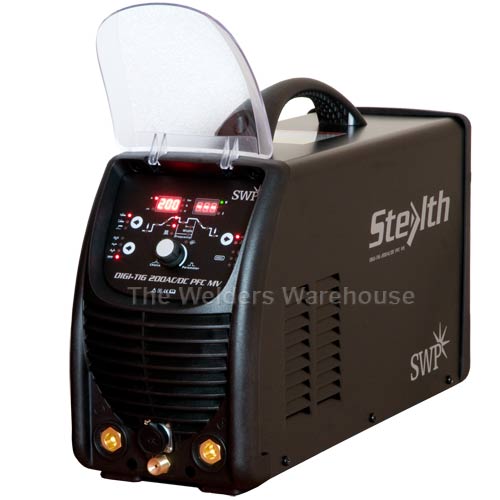
How Tig Welders Work
An arc is struck between a Tungsten Electrode and the workpiece. A weldpool will form under the arc, then the torch is moved along and, if necessary, filler wire is added to the weld pool.
The Weldpool is protected from oxidisation by a Gas Shield (usually pure Argon), which is poured over the weldpool by the Torch.
Although, technically, Tig Welding is very different to Gas Welding, the action, and therefore the skillset, is pretty much the same. So if you have experience of Gas Welding, you should take to Tig Welding like the proverbial Duck to Water!
The upside to Tig Welding is that it’s extremely versatile and affords great control. It’s therefore possible to produce very high quality welds on a range of metals.
The downside with Tig Welding is the process is slow and decent quality equipment is not cheap, although prices have come down in recent Years.
Types of Tig Welder
Tig Welders fall into 3 basic categories:
- DC Output Lift or Scratch Start (cannot weld Aluminium)
- DC Output with High Frequency Start (cannot weld Aluminium)
- AC/DC Output with High Frequency Start (CAN weld Aluminium)
DC Lift/Scratch Start Tig Welders
These are the least expensive and most basic form of Tig Welder. They are usually a DC Arc Welder, or an extra Mode on an Inverter Mig Welder.
To strike an Arc, the Tungsten Electrode is touched down onto the job then lifted off to form a welding arc (much the same as MMA welding).
The limitation of such a Tig Welder is that the tungsten electrode will try to stick to the workpiece when it is touched down and the Tig welders torch is permanently live.
I would only suggest this type of Tig Welding equipment to customers who primarily want to arc, or Mig Weld. For occasional, basic DC Tig Welding however, it’s a viable option.
DC with High Fequency Start
This type of Tig Welder uses a burst of high frequency (HF) to establish the welding arc.
This is easier and more precise than a Scratch start or Lift Tig Welder, as the Tungsten Tig Electrode does not have to be touched down.
A High Frequency (HF) start Tig Welder will usually have additional useful features such as Slope Down and Post Gas Flow.
If you’re seriouse about wanting to Tig Weld, you really should buy a High Frequency Start machine!
AC/DC Tig Welders
AC/DC Tig Welders are the most versatile, usually crammed with professional features and therefore, usually the most expensive.
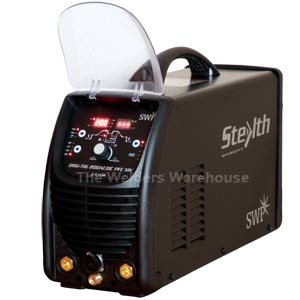
The key thing about AC/DC Tig Welders is that you can weld Aluminium. This is not possible with a DC only Tig Welder because you need an AC output to weld Aluminium and its alloys.
Tig Welder Control Features
Slope Up/Down
Slope Up is where the Tig Welder starts the welding arc at a very low current, then smoothly brings the welding power up to the level set by the operator.
Some Tig Welders have a pre set Slope Up time that cannot be adjusted, some have manual control that allow different Slope Up times to be set.
Slope down works in the same way but at the end of the weld. When the torch trigger is released, the Tig Welder will fade the power down, instead of stopping it suddenly.
Stopping a Tig Welder arc suddenly can cause the centre of the weld to sink (known as “Cratering”). This phenomenon can even lead to a pin hole in the end of the weld. Fading the Tig Welders arc allows the weld pool to solidify more slowly to avoid Cratering.
Pre/Post Welding Gas Flow
Pre Gas Flow is where the Tig Welder turns on the gas before the arc. This ensures a good welding gas shield.
Post Gas Flow is where the Tig Welder keeps the welding gas flowing after the arc has extinguished. This is important as it prevents the hot tungsten electrode and the end of the weld from oxidising as it cools.
Pulse Welding
A Tig Welder with Pulse control allows the operator to weld very thin material with a little more control.
The principle is that the Tig Welder emits a burst of higher power to achieve penetration. The burst of High Power is followed by a burst of lower power to prevent blow through.
Pulse welding can also be used to achieve penetration on thicker material whilst at the same time, limiting weld size.
AC Frequency Control
An AC/DC Tig Welder may have AC Frequency Control.
AC frequency is the speed at which the polarity of the Tig Welding Torch switches from positive to negative and is measured in Hz (Switches per second).
A Tig Welder with fixed frequency usually switches at around 70 – 100Hz.
A Tig Welder with variable frequency control will typically have a range of around 50 – 250Hz.
The effect the frequency has is to “focus” the Tig Welding arc, in the same way you would focus a torch beam.
The higher the frequency, the more focused the welding arc.
Higher frequency would normally be used to gain greater penetration on thick aluminium, repairing a crack in a casting for example. Lower frequency would be used on thinner sheet aluminium where the heat of the welding arc needs to be spread more to avoid blow through.
Tig Welder Control Panels can look quite complex on first sight. But they are not as intimidating as they look, in fact, most are quite intuitive.
Conclusions
Tig Welders have come down a lot in price in recent Years. Yet at the same time, the level of sophistication has gone up!
Given there is a big price difference between DC only and AC/DC output machines, the first place to start is to ask yourself the question:
Do I need/want to weld Aluminium?
To weld Aluminium, you will need to buy an AC/DC Tig Welder. If not, you can buy a DC only Tig Welder.
If you’re going to buy a DC Tig Welder, my heartfelt opinion would be to buy a High Frequency Start machine.
Visit our Tig Welders Page to view our current range.
If you also want a Mig, then a machine like one of our Synergic iMigs are a great choice. These have a mode for Lift/Scratch Start Tig (with optional Torch). But HF Start Tig is always going to be a better if you plan on doing a fair bit of Tig Welding.
I hope you found this blog article about Tig Welders useful. If you did;
Please let me know what you thought by leaving a comment.
Don’t worry, your email address won’t be added to a database or shared and you won’t receive any unsolicited email.
Cheers
Graham


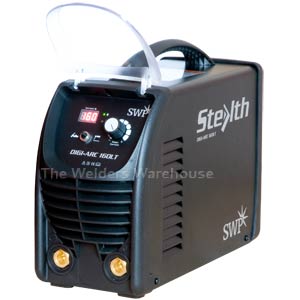
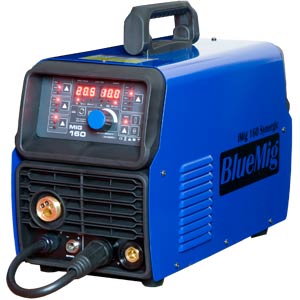
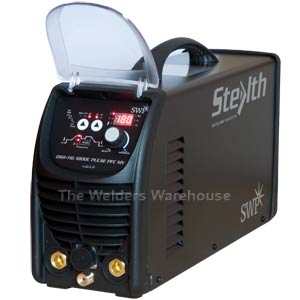
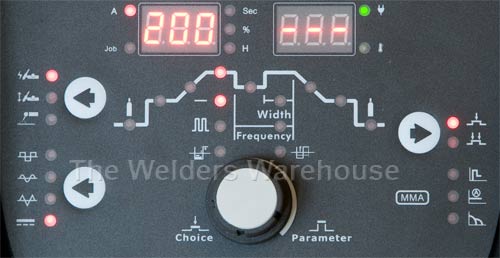
Hi Graham nice one for the notes lah
Hi Cian
Glad you found the article useful.
Regards Graham
Can I use my old German made mig welder as a tig welder
Hi Rodney
Sorry, you can’t.
Migs are whats called “Voltage Dependent”, this means that when you adjust power, your adjusting the arc voltage to a fixed value, the current (amps) will be determined by voltage, wire diameter and arc length and is variable.
Tig Welders are “Current Dependent”, this means when you adjust power, you’re changing the arc current, voltage will be determined by the amount of current (amps) and arc length and is variable.
Modern Inverter Migs are often capable of Tig Welding, usually DC only, but older Transformer based Migs are not.
Sorry it’s not the answer you wanted, but hopefully helpful 🙂
Cheers Graham
Hi Graham,
Thank you for the excellent explanation.
I have done loads of MIG but zero TIG.
I am slightly intimidated by the example control panel shown.
I cannot fully relate your parameter descriptions to the example panel.
Could you please explain the relevance of the Width” parameter.
Could you please explain the application of the sawtooth and square waveforms for the AC (lower left arrow).
Thank you
Kindest Regards
Tim
Hi Tim
The Width would be how long a Pulse of Higher Current is.
Can’t say I’ve used a Sawtooth Waveform, but it’s designed to reduce heat input and is supposed to be good for welding thin Aluminium, it also allows faster travel speeds.
Squarewave is the more common and has been around for Years, offers deeper penetration than the orriginal Sinewave and a fast freezing weld pool.
Hope that helps.
Cheers
Graham
Simplified descriptions that inform well are rare. This is a great example. Thanks Graham. You take the mystery out brilliantly.
Hi John
Thank you for the generous comment. Simple explanations in plain English is what I’ve tried to achieve, so its great to know the effort is appreciated 😀.
Best regards
Graham
This article on Tig Welders provides a straightforward and easy-to-understand guide for those looking to learn the basics of Tig welding and decide which type of machine to purchase. The breakdown of different types of Tig Welders, such as DC Output Lift or Scratch Start, DC Output with High Frequency Start, and AC/DC Output with High Frequency Start, is informative and helps readers understand the capabilities and limitations of each.
The article does an excellent job of explaining key concepts related to Tig welding, such as pre/post welding gas flow, pulse welding, and AC frequency control. These explanations offer valuable insights into how these features can enhance the welding process, improve control, and produce high-quality welds.
I appreciate the inclusion of the AC/DC Tig Welder control panel example, as it helps demystify what may initially seem complex for beginners. It’s reassuring to know that most control panels are intuitive and user-friendly.
The article concludes with practical advice on considering the need to weld aluminum and the benefits of opting for HF Start Tig for frequent Tig welding tasks. The author’s willingness to receive feedback and maintain privacy regarding contact information is also commendable.
Overall, this guide provides a great starting point for anyone interested in Tig welding, offering clear explanations and insights into different types of Tig Welders. The Welders Warehouse continues to provide valuable resources for the welding community.